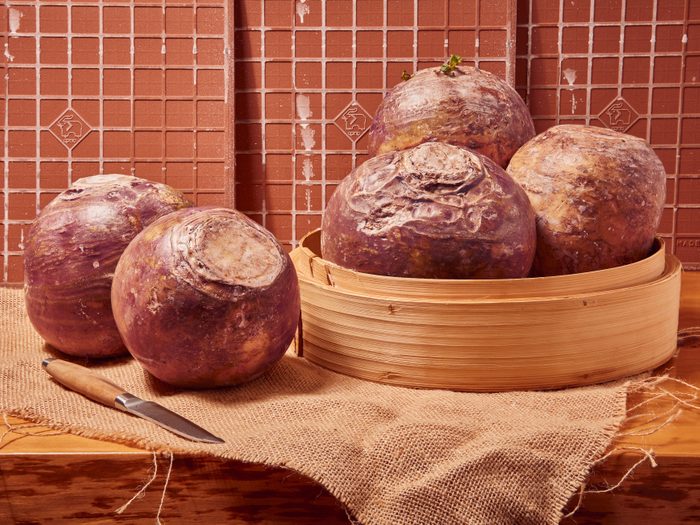Why You Need to Add Rutabagas to Your Winter Veg Rotation

Expand your root vegetable repertoire with this nutritious winter delight.
The depths of winter don’t exactly bring cooking enthusiasm. Juicy stone fruits and perfectly ripe tomatoes disappeared once the days grew shorter, and the turkey-packed excitement of the holidays has come and gone. It’s times like these when you need to dig deeper for cooking inspiration. Luckily, there are delicious foods just below the surface of the earth. This winter, try rutabagas, a versatile and overlooked vegetable.
First discovered in Scandinavia, rutabagas are hardy root vegetables that are likely a hybrid between a turnip and a cabbage. They’re sometimes called Swedish turnips, or Swedes for short, a nod to their Scandi origin. Although related to the turnip, rutabagas have a different flavour profile: They’re sweeter and lack the same bitter, peppery bite. Rutabagas also have golden yellow flesh instead of a white interior.
Rutabagas like cool weather, as their sweet flavour is enhanced by exposure to frosts. The vegetable also takes well to storage in cool cellar temperatures, which made them a reliable food source during the winter months before the invention of refrigeration. You’ll find the root veg in season from as early as November, when they’re harvested, through March.
Rutabaga nutrition facts
Rutabagas are lower in carbohydrates than other starchy vegetables like potatoes or squash. In fact, they have about half as many carbs per serving as potatoes and are a good source of fibre. Fibrous foods allow for a slower release of sugars. This reduces large spikes in blood sugar levels, which helps control hunger hormones and prevents the development of chronic diseases like type 2 diabetes and cardiovascular disease over time. Plus, they’re high in important nutrients like vitamin C, potassium and magnesium, which play roles in immune function and nerve transmission.
Like other members of the brassica family, such as Brussels sprouts, cauliflower and cabbage, rutabagas contain bioactive compounds called glucosinolates. As antioxidants, glucosinolates shut down the action of carcinogens and clear out pesky free radicals that can cause damage to cells. Glucosinolates also fight inflammation in the body by setting off a cascade of activity, including activating detoxification enzymes in the liver and triggering immune functions, all of which decreases the risk of developing cancer and other chronic diseases. Some glucosinolates are even capable of limiting and preventing tumour growth. Long story short, eat your brassicas! They’re good for you.
(Related: What Are the Health Benefits of Mushrooms?)
What to look for when buying rutabaga
Rutabagas have a craggy surface, but when you’re shopping, look for ones that have an undamaged peel and feel firm. Avoid any that are woody or dull-looking. Rutabaga peels are often given a waxy coating (which is removed when you peel the veggie) to help them keep longer, so don’t be alarmed if they feel a bit sticky at the grocery store. They’ll keep for up to three months when stored in a cool, dry place or in the refrigerator.
How to cook rutabaga
An easy sub for other starches, rutabagas can be used anywhere you would a potato. Slice them into sticks or wedges and roast them until crisp. Boil them and “mix and mash” with other root vegetables like squash and sweet potatoes to create a delicious and healthy alternative to mashed potatoes. Peel and grate rutabagas to create a lower-carbohydrate version of latkes or fritters. If you’re craving something sweet, stir grated rutabagas into muffins to add fibre and moistness. Serve rutabagas as a side dish with steak, pork or lamb—the vitamin C in rutabagas will help you absorb the meat’s iron more effectively.
Try using them in puréed soups to bring silkiness and body without the milk or cream. And rutabagas can go beyond your standard root vegetable: They also perform exceptionally well as veggie noodles made with a spiralizer, where their texture is perfect for creating tender, al dente strands that don’t turn to mush like other vegetables (ahem, zucchini). With a little creativity, rutabagas quickly become a kitchen workhorse. This winter, branch out from potatoes and carrots and delve into some of the more rugged-looking tubers and roots—they deserve the love and a spot on your table too.
Laura Jeha is a registered dietitian, nutrition counsellor and recipe developer. Find out more at ahealthyappetite.ca.
Next: Get the recipe for skillet shepherd’s pie with rutabaga mash.




